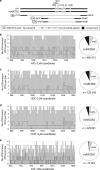Illumina-based analysis of microbial community diversity
- PMID: 21677692
- PMCID: PMC3246231
- DOI: 10.1038/ismej.2011.74
Illumina-based analysis of microbial community diversity
Abstract
Microbes commonly exist in milieus of varying complexity and diversity. Although cultivation-based techniques have been unable to accurately capture the true diversity within microbial communities, these deficiencies have been overcome by applying molecular approaches that target the universally conserved 16S ribosomal RNA gene. The recent application of 454 pyrosequencing to simultaneously sequence thousands of 16S rDNA sequences (pyrotags) has revolutionized the characterization of complex microbial communities. To date, studies based on 454 pyrotags have dominated the field, but sequencing platforms that generate many more sequence reads at much lower costs have been developed. Here, we use the Illumina sequencing platform to design a strategy for 16S amplicon analysis (iTags), and assess its generality, practicality and potential complications. We fabricated and sequenced paired-end libraries of amplified hyper-variable 16S rDNA fragments from sets of samples that varied in their contents, ranging from a single bacterium to highly complex communities. We adopted an approach that allowed us to evaluate several potential sources of errors, including sequencing artifacts, amplification biases, non-corresponding paired-end reads and mistakes in taxonomic classification. By considering each source of error, we delineate ways to make biologically relevant and robust conclusions from the millions of sequencing reads that can be readily generated by this technology.
Figures




References
-
- Blattner FR, Plunkett G, III, Bloch CA, Perna NT, Burland V, Riley M, et al. The complete genome sequence of Escherichia coli K-12. Science. 1997;277:1453–1462. - PubMed
-
- Cardenas E, Wu WM, Leigh MB, Carley J, Carroll S, Gentry T, et al. A combined massively parallel sequencing—indicator species approach revealed significant association between sulfate-reducing bacteria and uranium-reducing microbial communities. Appl Environ Microbiol. 2010;76:6778–6786. - PMC - PubMed
Publication types
MeSH terms
Substances
LinkOut - more resources
Full Text Sources
Other Literature Sources

